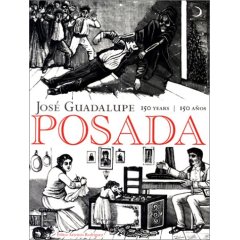José Guadalupe Posada: 150 Years
Everyone who celebrated the Mexican holiday Day of the Dead last November 2 owes a debt to José Posada. The 19th century printmaker’s etchings of creepy but playful skeletons, or calavera, are such a common household decoration it can be difficult to remember that they had an original creator.
José Guadalupe Posada’s artwork was pervasive in Mexico in the 19th century. At his peak, the peasant-born, working class Posada illustrated text for 12 newspapers, as well as issuing broadsheets, sensationalized handouts that played up the general public’s taste for the lurid, describing in breathless detail murders, grotesque births, and sightings of the devil, as well as poking fun at corrupt political figures. In fact, Posada’s use of skeletons to represent corruption predates more well-known expressionists.
Although somewhat unknown in the United States, there has recently been a revival of his work in Mexico. Artists such as Diego Rivera have cited Posada as a primary influence, and at last his work has begun to be elevated from commercialized folklore to the respect it deserves, and his influence in shaping modern Mexican art is acknowledged.
Posada did face obstacles to getting critical acclaim for his work. Then, just like now, there was a tendency to dismiss popular cartoonists as not being serious artists. European art was considered the standard of fine art, and most Mexican artists emulated their style rather than embracing the aspects of their culture and creating a unique style that is distinctly Mexican. Posada was the first to do this.
Still, the influences of European art are still present in his work, giving his etchings the feel of an Edward Gorey sketch crossed with Medieval European Catholic art. The result is often so deliciously creepy that to this day Posada wipes the floor with any Goth.
Editor Artemio Rodríguez's choice to group Posada's etchings into thematic categories gives the reader a chance to see the evolution of his printwork, from the earlier etchings to his later years, when the detail of his work is breathtaking. Page 77 shows a cartoony etching of a man and woman embracing. The characters are very simply drawn, and it seems the triumph is in creating the work at all rather than the work itself. In contrast, an etching on the same theme done in later years on page 73 is quite different. The man's hand is gently guiding the woman's lips up to his, her body is leaning toward him, and his other hand is curled tenderly around her waist. Looking at it, you forget how difficult the creating of it actually is, and are able to focus solely on the passion leaping off the page.
His portrait of a circus actress (page 98) takes the art of European portrait painting, at its zenith in the 19th century, and turns it into a purely Mexican creation. The result is arresting, proving that Posada is indeed worthy of serious critical acclaim. His preternatural talent for drawing out the core of humanity in all his artwork, be it dancing calavera or a monk riding a bike, may have given strength to the popularity of the broadsheets. As fantastical as the text was - the book is bilingual, showing the original text with an English translation next to it - his illustrations often contained an essential truth.
Despite the popularity of his work, José Posada died in poverty in 1913, at the age of 61, his body unclaimed. He was buried in a pauper's grave in the Cemetery of Dolores, only to be exhumed seven years later and thrown, anonymous and unloved, into a common grave. Such an insult to the artist whose work arguably had the greatest impact on the Day of the Dead, a holiday devoted to honoring those who have passed.
But maybe, with the renewed interest in Posada's work, the honor will come when anthologies such as José Guadalupe Posada: 150 Years are studied and admired for the revolutionary artwork within.
________________________
First posted at the Journal for the Lincoln Heights Literary Society
José Guadalupe Posada: 150 Years
Artemio Rodríguez, Editor
2003 by La Mano Press
Softcover, 126 pp
ISBN: 0-9724735-0-5
Thursday, November 16, 2006
<< Home
